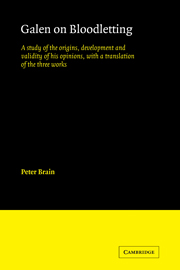 Galen on Bloodletting
Galen on Bloodletting Book contents
- Frontmatter
- Contents
- Preface
- Note on abbreviations and references
- Note on manuscripts and editions
- 1 Galen and his system: an introduction
- 2 Galen's Book on Venesection against Erasistratus (translation)
- 3 Galen's Book on Venesection against the Erasistrateans in Rome (translation)
- 4 Galen's Book on Treatment by Venesection (translation)
- 5 Development of Galen's views and methods as shown in the three works
- 6 Galen, venesection and the Hippocratic Corpus
- 7 Galen's practice of venesection
- 8 Galen's revulsive treatment and vascular anatomy
- 9 The testimony of other writers and the validity of Galen's opinions on sites for venesection
- 10 Galen's use of venesection as an evacuant: can it be justified? A medical digression
- 11 Conclusion
- Glossary
- Works cited
- Index
1 - Galen and his system: an introduction
Published online by Cambridge University Press: 04 August 2010
- Frontmatter
- Contents
- Preface
- Note on abbreviations and references
- Note on manuscripts and editions
- 1 Galen and his system: an introduction
- 2 Galen's Book on Venesection against Erasistratus (translation)
- 3 Galen's Book on Venesection against the Erasistrateans in Rome (translation)
- 4 Galen's Book on Treatment by Venesection (translation)
- 5 Development of Galen's views and methods as shown in the three works
- 6 Galen, venesection and the Hippocratic Corpus
- 7 Galen's practice of venesection
- 8 Galen's revulsive treatment and vascular anatomy
- 9 The testimony of other writers and the validity of Galen's opinions on sites for venesection
- 10 Galen's use of venesection as an evacuant: can it be justified? A medical digression
- 11 Conclusion
- Glossary
- Works cited
- Index
Summary
Galen (c. ad 129–200) was a Greek from Pergamon in Asia Minor. Because of his habit of putting autobiographical details into his works, we know that he was the son of a prosperous architect, Nikon, who named him Galenos (mild), perhaps in the hope that he would turn out different from his mother, who was a shrew. He speaks of his father with respect; he gave him an excellent education in literature, philosophy and the sciences, and finally sent him to Alexandria to study medicine after being advised in a dream to make him a physician. After a spell in Pergamon as medical officer to the gladiators, Galen went to Rome in 162 and quickly established a large and fashionable practice; the second bloodletting work gives a lively account of how he did it. It was not long before he was attending the emperor Marcus Aurelius, who had, if we can believe Galen, some very complimentary things to say about him. Galen wrote a short work, That the Best Physician is also a Philosopher, in which he condemned the ignorant and materialistically-minded doctors of his time, and urged physicians to emulate Hippocrates, who, at least according to Galen, had despised possessions and the pleasures of the table and the bed, and laboured unceasingly in the pursuit of knowledge.
- Type
- Chapter
- Information
- Galen on BloodlettingA Study of the Origins, Development and Validity of his Opinions, with a Translation of the Three Works, pp. 1 - 14Publisher: Cambridge University PressPrint publication year: 1986
- 1
- Cited by


